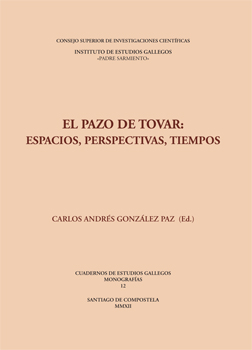
Materias 
- Arqueología y Prehistoria (172)
- Arte y Arquitectura (249)
- Ciencia y Tecnología (153)
- Ciencias de la Tierra (108)
- Ciencias de la Vida (182)
- Ciencias Sociales (161)
- Divulgación científica (304)
- Filosofía y Religión (113)
- Historia de la Ciencia (106)
- Historia e Historiografía (321)
- Información y Documentación (80)
- Lingüística y Filología (103)
- Literatura y crítica literaria (151)
Colecciones 
Autores 
Enviar a un amigo 
El Pazo de Tovar: espacios, perspectivas, tiempos
  Carlos Andrés González Paz (edicion) Filiación: Consejo Superior de Investigaciones Científicas. Instituto de Estudios Gallegos "Padre Sarmiento" (Santiago de Compostela, España) Biografía: Carlos Andrés González Paz. Licenciado con grado en Humanidades por la Universidad de Santiago de Compostela. Es especialista en Historia Medieval y del Renacimiento por la Universidade do Porto (Portugal, 2008). Actualmente se encuentra incorporado al IEGPS como Técnico Superior de Actividades Técnicas y Profesionales del CSIC. Temas de investigación. Sus líneas de investigación se centran en la organización socioeconómica del territorio, la historia religiosa -diocesana y monástica- de Galicia, la historia social de las mujeres y la sociología histórica de las peregrinaciones cristianas. |
Edición: Carlos Andrés González Paz Año de publicación: 2012 Idioma: español Materias: Historia e Historiografía |
Resumen:
La "cultura de los pazos" en Galicia ha sido descrita hace unas décadas como un fenómeno intrínsecamente gallego, moderno e hidalgo, armónicamente inserto en las estructuras, dinámicas y procesos socioeconómicos de sus tiempos y espacios con una visión decididamente elogiosa que lleva a la conclusión, lógica, de que «la despoblación de los pazos ha sido una pérdida real para la vida intelectual, social y económica de Galicia». Sin duda, esas luces, que muchos investigadores actuales destacan cada vez más, contrastan con el oscuro estereotipo lanzado por Emilia Pardo Bazán a finales del siglo XIX en Los Pazos de Ulloa, una novela repleta de gentes y edificios tenebrosos propios de un «país de lobos», donde las personalidades luminosas se veían irresolublemente condenadas a ser devoradas por las negruras de un mundo lóbrego que envilecía, empobrecía y embrutecía a sus habitantes. Un buen ejemplo es el pazo de Tovar, en Lourenzá (Lugo). Esta casa-fuerte medieval de singular estructura estuvo sucesivamente vinculada al monasterio benedictino de San Salvador de Lourenzá, a la estirpe Ponce de León, al linaje Aguiar, a la familia del mariscal Pedro Pardo de Cela, a Antonio de Tovar, contino de su sacra, católica y cesárea majestad imperial, a los marqueses de Villasante. Esta trayectoria pasada, de cierto esplendor en determinadas etapas, no impidió que sufriese doblemente. Tuvo que afrontar, por un lado, los múltiples males de sus piedras que amenazaban su propia conservación y, por otro lado, la presión de su devenir histórico, marcado por la historia general y la familiar de las gentes que lo ocuparon. Se convirtió así en un verdadero microcosmos, como eran hasta hace poco todas las grandes casas campesinas, pero también, por sus características nobles, que lo distinguían de ellas, en un epítome de nuestra historia medieval y moderna.
Información bibliográfica
Descripción física del libro: 184 p. : il ; 24 cm
ISBN: 978-84-00-09083-8
eISBN: 978-84-00-09581-9
Publicación: Santiago de Compostela : Consejo Superior de Investigacions Científicas, 2012
Referencia CSIC: 12261
Adquirir la edición digital en- e-libro Adquirir la edición impresa en |
Descargas gratuitasNo hay ninguna descarga disponible |
Este título está en nuestro catálogo electrónico desde el lunes 27 mayo, 2013.







